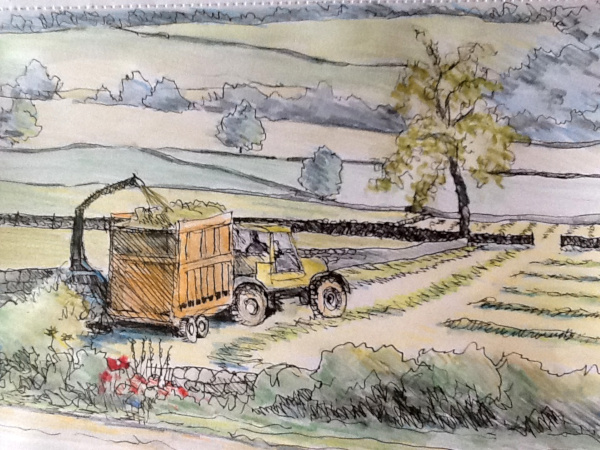Members’ sketches on the Harvest theme.
Author: Webmaster
Summer exhibition 2020
Pateley Bridge Art Club has launched its Summer art exhibition of members’ artworks online as part of the August 2020 NiddArt Trail. Members produced some work on shared or individual themes during isolation. View work at https://www.pateleybridgeartclub.org/aug-2020/
Samurai by Barbara Ward

Images for harvest theme
Sheep sketches
Members’ sketches to the theme.
Sheep drawings by Henry Moore

Comment on sheep drawings by Henry Moore – Audrey Culling
No matter how I draw or paint sheep, the result makes me laugh, so I thought I’d send a page of drawings by Henry Moore.
He had a small studio in Much Hadham in Hertfordshire which I visited once. It had a long low window overlooking fields where a local farmer grazed his sheep. They came very close to the window and Henry began drawing them. At first he saw them as balls of wool on legs but then he began studying them: the way they moved, the shape of their bodies under the fleece.
They bring strong human and biblical associations and, the sight of a ewe with her lamb, evoked the mother and child theme. A large form sheltering a small one, which became important in all his work.
He filled a sketchbook with sheep drawings and presented it to his daughter, Mary. He said, “Drawing, even for people who cannot draw, even for people not trying to produce a good drawing , makes you look more intensely.
Cartoon by John Watt

Sketching subjects for 15 August
Members can submit images by 15th August for including in the newsletter and at any time for sharing in the News Blog or post them directly to the PBAC Facebook group.
The images could be sketches, studies and ideas as well as finished pieces. We look forward to your feedback of artwork and ideas.
Email: pateleybridgeartclub@gmail.com
The photographs are copyright. Art club members have permission to create their own interpretations.









Thank You Pateley Bridge
Members’ Artwork
Sketching by members during lockdown


























Sketching Subjects May/June














Subjects for painting and drawing etc.
• Rocks
• Seaside
• Birds and flowers
• Historic buildings
• Flowers
• Landscape
• River scene
• People socialising
• Boats and ships
• Lily pond
• Railway scene
• Gardens
The photographs are copyright. Art club members have permission to create their own interpretations.
Members can submit images of their paintings, drawings etc. for sharing on the PBAC News Blog or post them directly to the PBAC Facebook group. The images could be sketches, studies and ideas as well as finished pieces. We look forward to your feedback of artwork and ideas.
Email: pateleybridgeartclub@gmail.com
Walking & sketching
Richard Ringshall : walking, sketching and writing.
Another sunny day during lockdown so time for another walk. My wife Rita and I decided to go a bit further today and have lunch at the Yorke Arms (‘at’ not ‘in’). From Pateley we took the river path to Wath, leaving at about 9am. At Wath, I looked longingly at the Sportsmans Arms (closed!) and continued along the river to Gouthwaithe Reservoir. We then followed the track alongside the reservoir to the village of Bouthwaite. Along this stretch of track we passed different types of sheep and lambs, beautiful flowers and now a large number of geese, not to mention stunning views. We also saw our first swallows of summer. On arrival at Ramsgill we sat and had our packed lunch and then I had a wander to see what I could sketch. I settled for a view of the church (also closed) from the roadside.
We returned to the southern end of the reservoir the same way but then continued straight up the track via Spring Wood Top, passing through masses of flowering rhododendrons, and then down into Wath taking the Wath Road back to Pateley Bridge.
About 9 to 10 miles of exercise and a couple of hours sketching. Time for a beer!

































